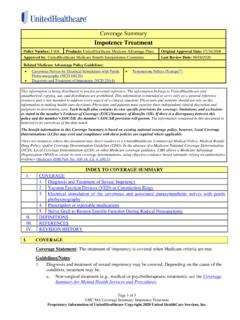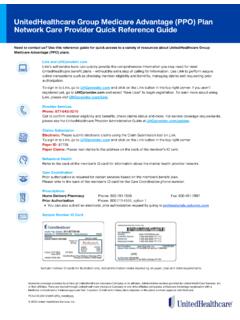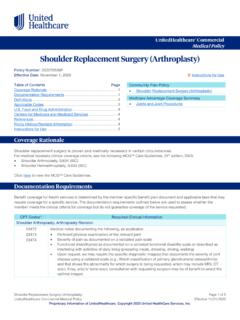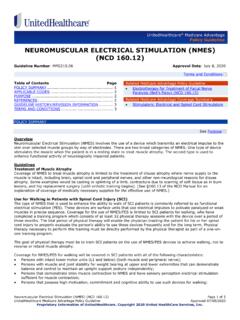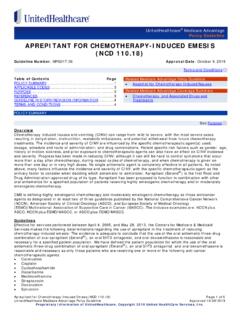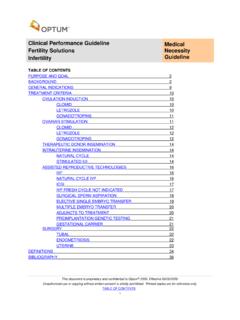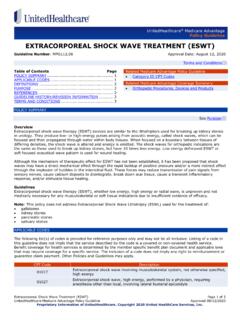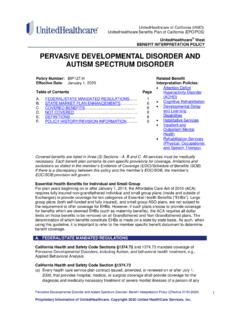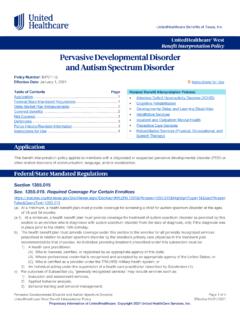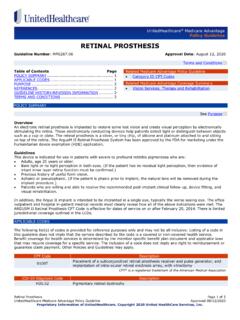Transcription of Vision Services, Therapy and Rehabilitation
1 UnitedHealthcare Medicare Advantage Coverage Summary Vision Services, Therapy and Rehabilitation Policy Number: Approval Date: August 17, 2021 Instructions for Use Table of Contents Page Related Medicare Advantage Policy Guidelines Coverage Guidelines .. 1 Computer Enhanced Perimetry (NCD ). Eye Examination .. 2 Corneal Topography Services of an Optometrist and/or Ophthalmologist .. 2. Endothelial Cell Photography (NDC ). Frames and Lenses .. 2. Hydrophilic Contact Lenses (NCD ). Vision Therapy .. 4. Annual Diabetic Retinal Examination .. 4 Hydrophilic Contact Lens For Corneal Bandage Glaucoma Screening .. 4 (NCD ). Scanning Computerized Ophthalmic Diagnostic Intraocular Photography (NCD ).
2 Imaging/Scanning Laser Glaucoma Tests/Optical Intraocular Lenses (IOLs) ( ). Coherence Test/Scanning Laser Polarimetry .. 4 Ocular Photodynamic Therapy (OPT) (NCD ). Verteporfin .. 4 Ocular telescope Keratoplasty/LASIK Procedure .. 5 Phaco-Emulsification Procedure Cataract Rehabilitation Services for Members with Vision Extraction (NCD ). Impairment .. 5. Photodynamic Therapy (NCD ). Intraocular Photography .. 5. Photosensitive Drugs (NCD ). Endothelial Cell Photography .. 5. Vitrectomy .. 6 Refractive Keratoplasty (NCD ). Phaco-Emulsification Procedure .. 6 Retinal Prosthesis Visual Tests Prior to and General Anesthesia During Use of Visual Tests Prior to and General Anesthesia Cataract Surgery.
3 7 during Cataract Surgery (NCD ). Computer Enhanced Perimetry .. 7 Verteporfin (NCD ). Glaucoma Surgical Treatments .. 7 Vitrectomy (NCD ). Avastin (Bevacizumab) .. 7. Lucentis (Ranibizumab) .. 7. Implantable Miniature telescope .. 7. Computerized Corneal 7. Corneal Pachymetry (Ophthalmic Ultrasound) .. 7. Retinal Prosthesis .. 8. Corneal Hysteresis Measurement .. 8. Definitions .. 8. Supporting Information .. 9. Policy History/Revision Information .. 12. Instructions for Use .. 12. Coverage Guidelines Vision services, Therapy and Rehabilitation are covered in accordance with Medicare coverage criteria. Vision Services, Therapy and Rehabilitation Page 1 of 12.
4 UnitedHealthcare Medicare Advantage Coverage Summary Approved 08/17/2021. Proprietary Information of UnitedHealthcare. Copyright 2021 United HealthCare Services, Inc. Eye Examination Eye examination by the member's physician for the treatment or diagnosis for a specific illness, symptom, complaint or injury is covered. Refer to the Medicare Benefit Policy Manual, Chapter 16, 90 Routine Services and Appliances. (Accessed August 10, 2021). For visual acuity screening, refer to the Initial Preventive Physical Examination (IPPE) section in the Coverage Summary titled Preventive Health Services and Procedures. Services of an Optometrist and/or Ophthalmologist Services of an optometrist and/or ophthalmologist are covered when medically reasonable and necessary for the diagnosis and treatment of an eye disease or injury.
5 Where more than one practitioner furnishes concurrent care, services furnished to a member by both an ophthalmologist and another physician (including an optometrist) may be recognized for payment if it is determined that each practitioner's services were reasonable and necessary. Refer to the Medicare Benefit Policy Manual, Chapter 15, Optometrist's Services. (Accessed August 10, 2021). Frames and Lenses Routine Corrective Refractive Frames and Lenses Eye examinations for the purpose of prescribing, fitting, or changing eyeglasses; eye refractions by whatever practitioner and for whatever purpose performed are not covered by Medicare, however, some members may have this benefit, including the frames and lenses through their UnitedHealthcare Medicare Advantage plan.
6 Refer to the member's Schedule of Benefit (SOB) to determine eligibility for this benefit and the applicable copayment/coinsurance will apply, if any. In some cases, Vision services may be provided by the medical group or by another Vision services provider. Contact the customer services department for assistance in determining the member's assigned Vision services provider. Refer to the Medicare Benefit Policy Manual, Chapter 16, 90 Routine Services and Appliances. (Accessed August 10, 2021). Post Cataract Surgery Frames and Lenses One pair of eyeglasses or contact lenses are covered after each cataract surgery, with the insertion of a conventional intraocular lens (IOL).
7 Refer to the: NCD for Intraocular Lenses (IOLs) ( ). NCD for Refractive Keratoplasty ( ). (Accessed August 10, 2021). There is no specific time frame after the cataract surgery when a member must receive the post-cataract lenses. However, to ensure that the lenses are still medically necessary, the lenses should be dispensed within 3 months of being ordered. For members who are aphakic and do not have an IOL, either because of surgery or congenital absence, the following lenses or combination of lenses are covered when determined to be medically necessary: a. Prosthetic bifocal lenses in frames (prescription eyeglasses);. b. Prosthetic lenses in frames (prescription eyeglasses) for far Vision and lenses in frames for near Vision (prescription eyeglasses); or c.
8 When contact lenses for far Vision are prescribed, coverage includes: contact lenses and prosthetic lenses in frames (prescription eyeglasses) for near Vision , and prosthetic lenses in frames (prescription eyeglasses) for when the contacts are removed ( , coverage for contacts for far Vision , eyeglasses for near Vision to be worn with the contacts, and eyeglasses for far Vision for when the contacts are removed). Vision Services, Therapy and Rehabilitation Page 2 of 12. UnitedHealthcare Medicare Advantage Coverage Summary Approved 08/17/2021. Proprietary Information of UnitedHealthcare. Copyright 2021 United HealthCare Services, Inc. Note: Prosthetic lenses (prescription eyeglasses) that have ultraviolet absorbing or reflecting properties may be covered in lieu of the regular (untinted) prosthetic lenses mentioned in (a),(b) and(c) above if it has been determined that such lenses are medically reasonable and necessary for the individual patient.
9 Refer to the: Medicare Benefit Policy Manual, Chapter 15, 120 Prosthetic Devices. NCD for Intraocular Lenses (IOLs) ( ). (Accessed August 10, 2021). Hydrophilic Contact Lenses for Corneal Bandage FDA-approved hydrophilic contact lens used as moist corneal bandages for the treatment of acute or chronic corneal pathology are covered: Bullous keratopathy Dry eyes Corneal ulcers and erosion Keratitis Corneal edema Descemetocele Corneal ectasis Mooren's ulcer Anterior corneal dystrophy Neurotrophic keratoconjunctivitis Hydrophilic contact lenses are not covered when used in the treatment of non-diseased eyes with spherical ametropia, refractive astigmatism and/or corneal astigmatism.
10 Refer to the: NCD for Hydrophilic Contact Lens For Corneal Bandage ( ). NCD for Hydrophilic Contact Lenses ( ). (Accessed August 10, 2021). Hard/Rigid Contact Lenses for the Treatment of Keratoconus Hard/rigid contact lenses for the treatment of keratoconus are covered. Note: Routine physical checkups; eyeglasses, contact lenses, and eye examinations for the purpose of prescribing, fitting, or changing eyeglasses; eye refractions by whatever practitioner and for whatever purpose performed; hearing aids and examinations for hearing aids; and immunizations are not covered. The routine physical checkup exclusion applies to (a) examinations performed without relationship to treatment or diagnosis for a specific illness, symptom, complaint, or injury; and (b) examinations required by third parties such as insurance companies, business establishments, or Government agencies.
